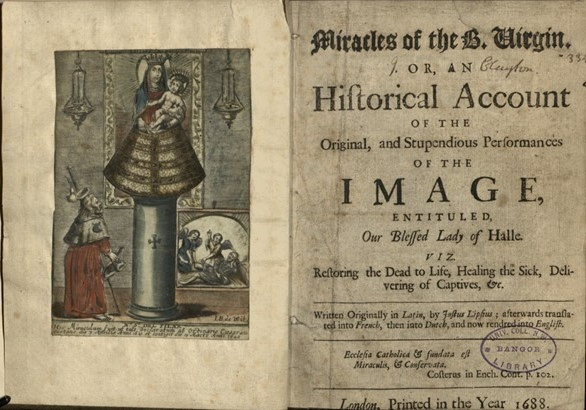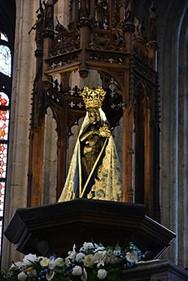
In 1604 the Flemish humanist, philosopher, classical scholar and moral and political theorist Justus Lipsius (1547–1606) published a Latin treatise on miracles by the Virgin Mary said to have happened in Halle, a small town near Brussels. The original book was soon translated into other languages: two Dutch translations published 1605 and 1607, a French translation, and an English translation.
Lipsius was considered to be the leading editor of Latin prose text. He was born October 18th, 1547, in Overijse, near Belgium. Appointed to the chair of history and philosophy at the recently established University of Jena, Thuringia, in 1572, he later accepted the chair of history and law at the new University of Leiden, the Netherlands (1578) and that of history and Latin at Leuven (1592).
Lipsius’ first visit to the Lady of Halle took place in 1601.

Ludwig IV, Landgrave of Thuringia sent the Lady of Halle and three other black Madonnas home to his wife, St Elizabeth of Hungary (d. 1231) on his way back home from the Crusades. St Elizabeth left it to her daughter, Sophie of Brabant, who in turn left it to her daughter, Matilda, Countess of Holland, who then gifted the statue in her grandmother’s name to the church of St Martin in 1276. Halle became the most important Marian shrine in Belgium.
The church was declared a basilica in 1946, an honor given by the Catholic church to a church or building that have become international centers of worship due to their association with a major saint or important historical event.
In 1602 Lipsius donated his pen with which he had written his major works to the shrine of the Madonna of Halle. Not long after, he was given access via the Bishop of Antwerp’s secretary, who had previously been a student of Lipsius, to a copy of the register listing miracles performed by the Lady. Miracles attributed to the Madonna include saving the city from various sieges in 1489 and later in 1850, raising people from the dead, and healing many of the sick.
One of my favorites of the miracles is:
A Taylor having swallowed his Needle, was delivered from the danger attending it by the Blessed Virgin
Bartholomew Broeck, a Tayor of the City of Denremonde, being busied about his work, put his Needle and Thread into his Mouth, that he might have his hands free; being intent on his work, and forgetting his Needle, he unhappily swallowed both that and the Thred. Afterwards he complained to his Wife, who consulted the Physicians and followed their advice, but in vain; After it had remained in his Body four days, he went to Mechlen to his Brother, who was a Physician; but he could not force it out of his Body by any Drinks or Purge. It happened that on a Saturday his Brother made a small feast, to entertain his sorrowful Guests, which being done, the Bell Rung to that service which is called the Praise of the B. Virgin; his Brother went unto the Church, but Bartholomew stayed behind; As he was musing, our Lady of Hallee came into his thoughts, he presently sent a fervent Vow unto her, and immediately he felt something between his Teeth, and pulled out the Needle and Thread. He joyfully shewed his Brother this great Miracle, and thankfully visited the B. Virgin of Halle; and he had great reason so to do, for his life had hung many days upon a Needle and Thred.
Bangor’s copy is dated 1688 and has a wonderful frontispiece depicting the Madonna and Child on a plinth signed by I. B. de Wit. The Lady of Halle is a portrayal of Mary as virgo lactans, or nursing virgin, whose exposed breast is offered to the Christ-child. I. B. de Wit’s portrait of the Virgin depicts Mary cloaked, and her breast covered, as is the case in many devotional prints of the shrine post the medieval period. Bangor’s copy of Lipsius’ work was purchased as part of the Watkin Library with funds made available through the kind donation of £47,000 made by Dr Evan Thomas to the University in 1892.
Shan Robinson.
